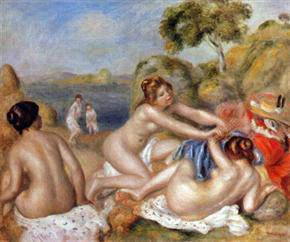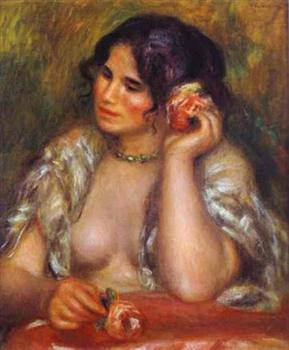
Pierre-Auguste Renoir
Bathers Playing with a Crab, c. 1897
Cleveland Museum of Art

Pierre-Auguste Renoir
Gabrielle with a Rose, 1911
Musee d’Orsay
Exhibition at the Philadelphia Museum of Art surveys Renoir’s final decades The Philadelphia Museum of Art presents the first exhibition to survey the achievement of the great Impressionist painter Pierre-Auguste Renoir (1841-1919) during the last three decades before his death. From June 17 through September 6, 2010]]>
Source: Philadelphia Museum of Art
Some 80 of the artist’s paintings, sculpture, and drawings will be on view, accompanied by a selection of works by Henri Matisse, Pablo Picasso, Pierre Bonnard, and others who were inspired by the master. A landmark exhibition, Late Renoir examines new directions that the artist explored several decades after he and others such as Claude Monet and Camille Pissarro created the new style of painting known as Impressionism. This new and widely admired phase in Renoir’s career propelled him into the modern age and, at the same time, enabled him to recapture a classical past with expressive brushwork and a palette of sensuous colors that were both lyrical and decorative. Late Renoir includes major works on loan from public and private collections in Europe, the United States, and Japan.
The exhibition is co-organized by the Reunion des Musées nationaux, the Musée d’Orsay, and the Los Angeles County Museum of Art, in collaboration with the Philadelphia Museum of Art. It drew some 420,000 visitors in Paris before traveling to the Los Angeles County Museum of Art. The Philadelphia Museum of Art will be the only East Coast venue.
“Renoir has a special importance in Philadelphia, which will be the best place in the world this summer to appreciate the breadth and distinctive character of all that he achieved during the last several decades of his life,” said Timothy Rub, The George D. Widener Director and Chief Executive Officer of the Philadelphia Museum of Art. “In 1933, the Museum presented the first museum exhibition ever to be devoted to Renoir in the United States and it is now the largest lender to Late Renoir. The Museum’s collection is rich in his works as well as those of his contemporaries, and nearby in Lower Merion, the Barnes Foundation also contains the world’s largest private collection of Renoir’s late paintings. Thus, visitors to Philadelphia will have a double opportunity to experience the most joyful but least understood and, to some, the most rewarding phase of this great artist’s career.”
Renoir had played an active part in the first Impressionist exhibition of 1874, presenting his work alongside those of his friends Degas, Monet, Pissaro, Sisley, and Morisot. He began eventually to distance himself from the group however and by the 1880s he embarked upon new avenues of expression, returning after many years to commissioned portraits. Now less interested in capturing the fleeting moments of everyday life, he also began to pursue timeless subjects, especially the theme of the female nude which became more central as he modeled his figures on the postures of classical sculpture. He opened an artistic dialogue with such old masters as Raphael, Titian, Rubens, Fragonard, and Watteau, while employing fluid brushstrokes and a bright palette that was inspired by his move from Paris to the south of France. Many of Renoir’s late works suggest an endless summer in which youthful, Arcadian figures inhabit a world of beauty and grace. This is the focus of the period from 1890 until Renoir’s death in 1919.
Follow us on:

